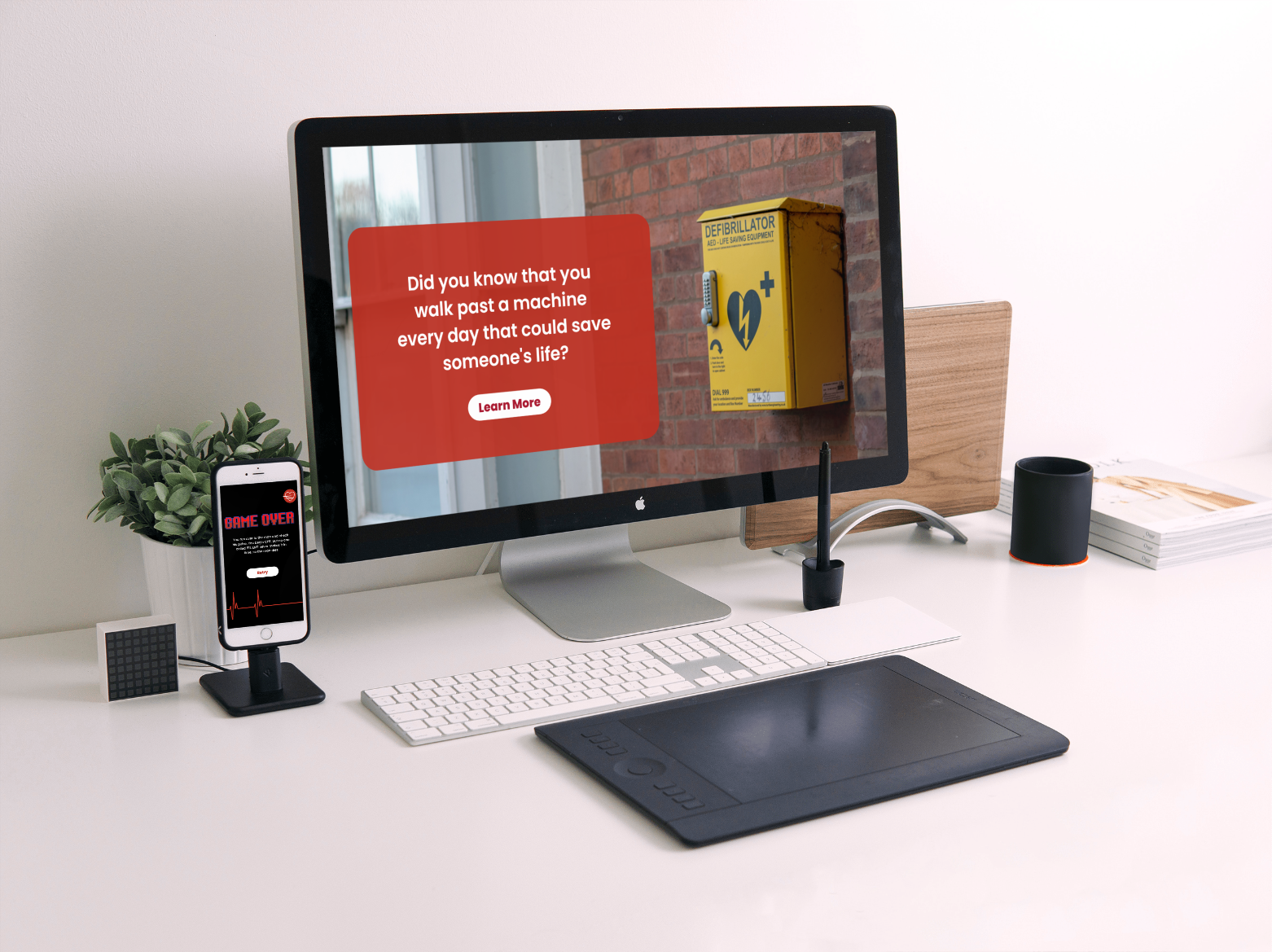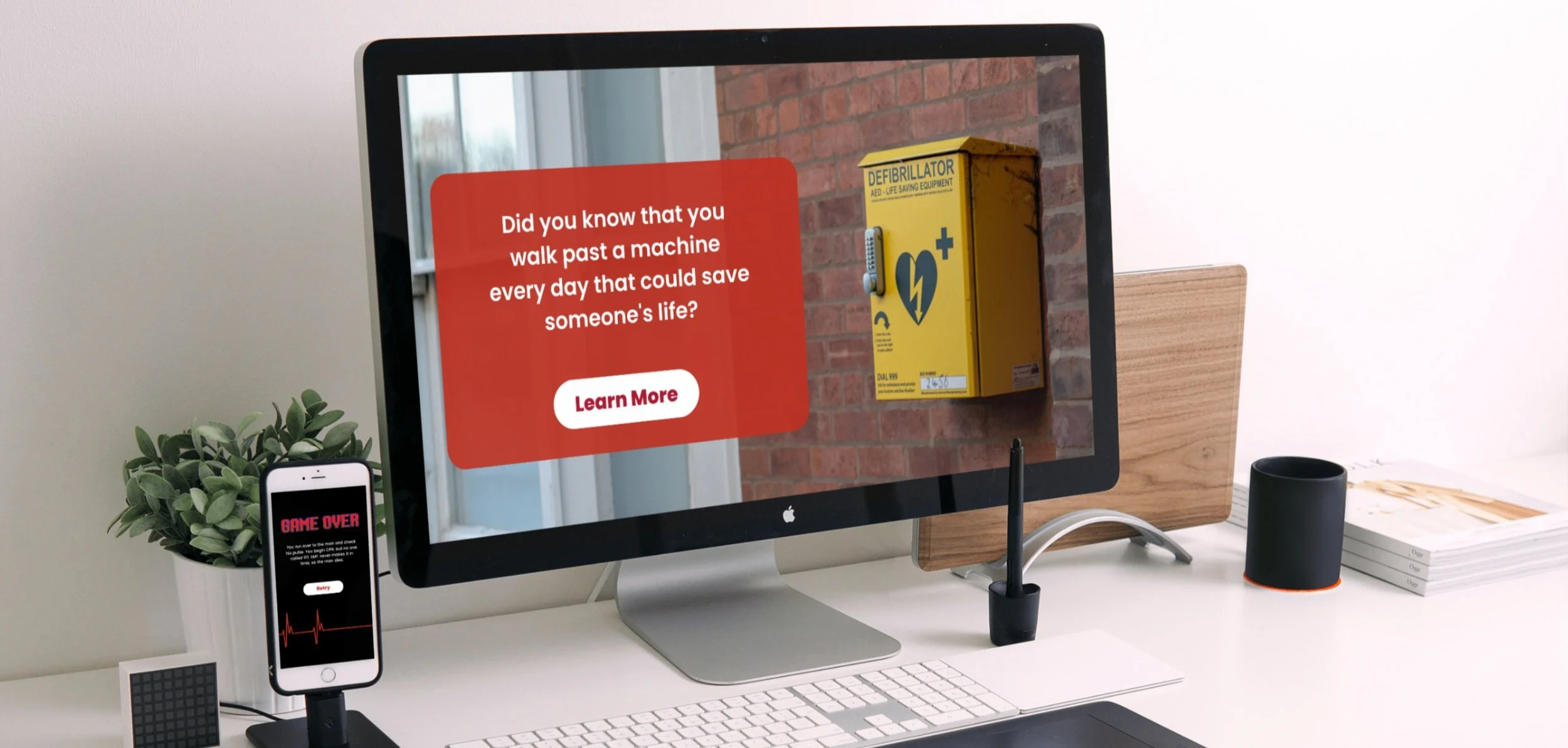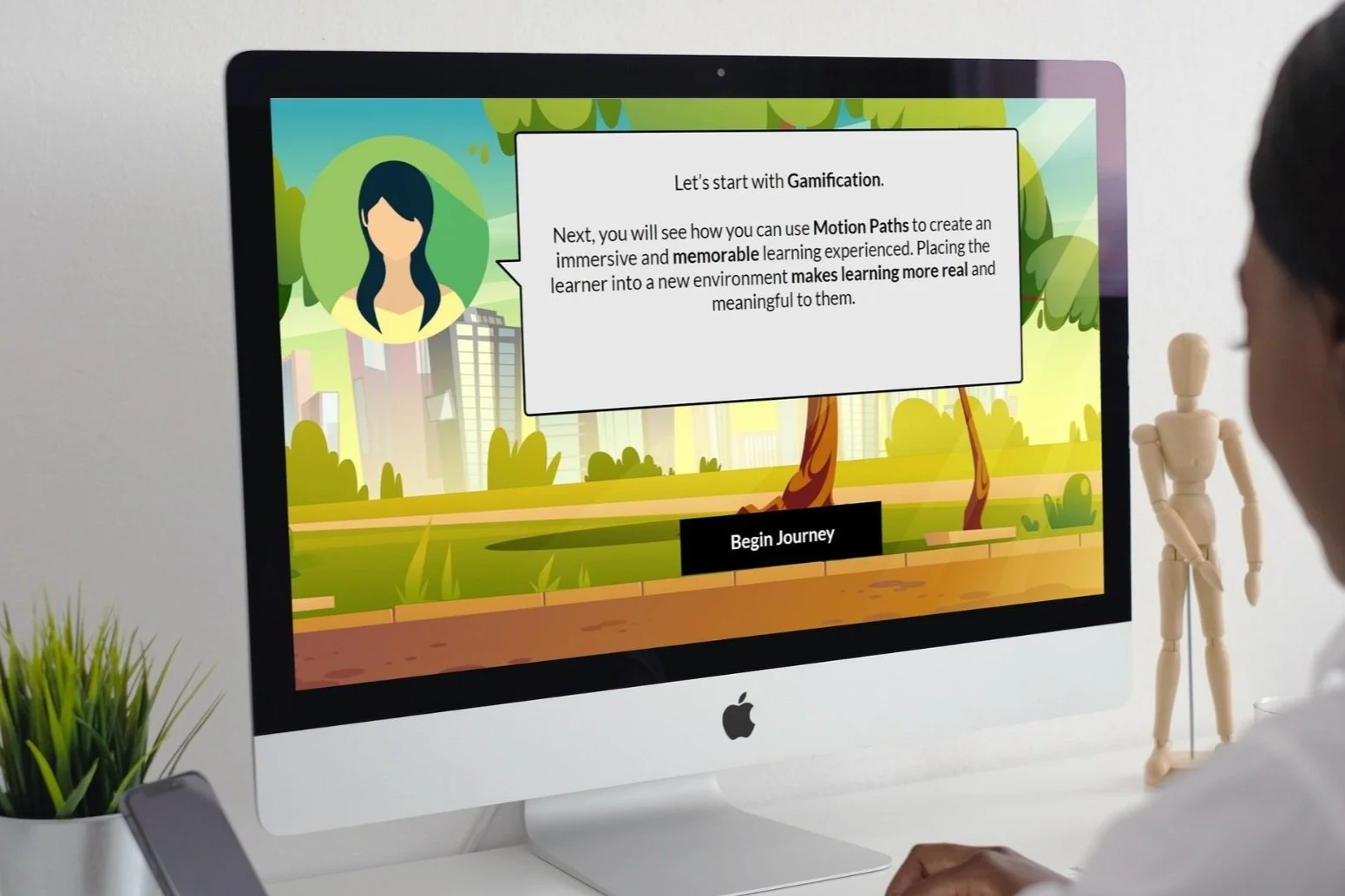

OVERVIEW
This scenario-based eLearning simulation applies gamification to teach employees how to use an AED to save the life of a person in cardiac arrest.
Workplace Safety Training
This scenario-based eLearning simulation helps employees at a mid-sized company make the right decisions and minimize fatalities from cardiac arrests.
Audience: employees at all levels
Responsibilities: Instructional Design, eLearning Development, and Visual Design
Tools Used: Articulate Storyline 360, Adobe XD, Audacity, and Canva
Workplace Safety and CPR Training
This scenario-based eLearning simulation helps employees at a mid-sized company make the right decisions and minimize fatalities from cardiac arrests.
Audience: employees at all levels
Responsibilities: Instructional Design, eLearning Development, and Visual Design
Tools Used: Articulate Storyline 360, Adobe XD, Audacity, and Canva
In this concept project, the client, a mid-sized company, reached out to me for assistance with their workplace safety initiatives. They wanted all of their employees to be able to operate the new AEDs that have been added to all of their branch locations.
Training on using the new AEDs would significantly improve workplace safety. AEDs save almost 2,000 lives each year in the US alone, and using an AED on a person in cardiac arrest increases survival by over 60%. There are over 350,000 cardiac arrests that occur outside of hospitals each year and about 10,000 of them happen in the workplace.
A needs analysis revealed that employees see value in learning first aid and CPR as it had a direct impact on their lives. Some employees also reported that learning to save a life would make them feel empowered and more secure at work and when they are at home.
Problem and Solution
I proposed a scenario-based eLearning experience that allows learners to make real-world decisions in a life or death situation and see the consequences of their decisions in a low-risk environment. I also proposed light gamification including a heart that would keep being if they chose the correct actions and to help learners recognize the impact that their actions had on people’s survival.
Process
I worked closely with Subject matter Experts (SMEs) to design and develop the interactive simulation. I used action mapping, a text-based storyboard, scenario-based eLearning, gamification, Canva, Audacity, Adobe XD, and Articulate Storyline 360 to create this real-life experience.
Action Map
I worked with SMEs to develop an action map. Focusing on the actions, we defined exactly what employees should do if they came across someone who was under cardiac arrest. Once the client approved the action map for the eLearning experience, I moved on to creating a text-based storyboard.
Once the action map was approved, I worked with SMEs to create a realistic story around the actions and the consequences of common mistakes that occur during these emergencies.
I decided to place the learner in the story where they come across a man who seems to have passed out. The learner would face choices of what to do at each step along the way. As they advance through the story, they discover that the man has no pulse and is not breathing. They have to perform CPR correctly to resuscitate him.
Text-Based Storyboard
When the learners choose the correct action, they will progress through the story. If a wrong action is selected, the learner will be presented with the real-life consequences on a “Game Over” page and are provided with a “Retry” button that leads them back to the last choice.
In the final scenario, the learner is presented with a pile of cards that they have to drag and drop to either the left for true or the right for false. If a card is on the wrong side after clicking the “Submit” button, a “Game Over” page will appear and an option to either try again with help or try again without help.
I included all of this in a text-based storyboard that consists of the script, various options, consequences for each choice on the “Game Over” pages, and a true/false card game at the end.
Working with and receiving feedback from the SMEs helped me develop a realistic scenario that mirrored the experience of performing CPR on a victim in cardiac arrest while the learner is in a safe environment. This helped create authentic consequences for making the wrong decisions in this type of emergency.
Prototype
Once the text-based storyboard was approved, I developed an interactive prototype. As requested by the client, the visuals incorporated photographs of real people and a color scheme that is commonly seen in hospitals and medical equipment (firetruck red, sky blue, and white).
The prototype featured an introduction, the beating heart, two sets of choices with corresponding consequences, and “Game Over” pages.
Final Product
After applying the feedback on the prototype, I began developing the final product. As the text-based storyboard and prototype were already approved, this next stage was fairly straightforward.
Takeaways
This is a concept project based on rescue training I once received. The final product was handed over to the client and they integrated it into their Workplace Safety Training program. In this eLearning project, the action mapping approach was used to focus on the actions that employees needed to perform to properly use the new AEDs.
This memorable eLearning experience should be instrumental in improving safety at their various locations. Going forward, I hope to use my instructional design skills on meaningful projects like this that can have a major impact on people’s lives.
You may also like…
Diversity and Cultural Sensitivity Training
This scenario-based eLearning simulation was developed for an international organization to build cultural competency in a very diverse workplace.
Gamified Instructional Designer eLearning Experience
This interactive and gamified eLearning experience inspires instructional designers at a large company to use modern tools and features in their eLearning projects
Problem and Solution
In this concept project, the client, a mid-sized company, reached out to me for assistance with their workplace safety initiatives. They wanted all of their employees to be able to operate the new AEDs that have been added to all of their branch locations.
Training on using the new AEDs would significantly improve workplace safety. AEDs save almost 2,000 lives each year in the US alone, and using an AED on a person in cardiac arrest increases survival by over 60%. There are over 350,000 cardiac arrests that occur outside of hospitals each year and about 10,000 of them happen in the workplace.
A needs analysis revealed that employees see value in learning first aid and CPR as it had a direct impact on their lives. Some employees also reported that learning to save a life would make them feel empowered and more secure at work and when they are at home.
Process
I worked closely with Subject matter Experts (SMEs) to design and develop the interactive simulation. I used action mapping, a text-based storyboard, scenario-based eLearning, gamification, Canva, Audacity, Adobe XD, and Articulate Storyline 360 to create this real-life experience.
Action Map
Text-Based Storyboard
Once the action map was approved, I worked with SMEs to create a realistic story around the actions and the consequences of common mistakes that occur during these emergencies.
I decided to place the learner in the story where they come across a man who seems to have passed out. The learner would face choices of what to do at each step along the way. As they advance through the story, they discover that the man has no pulse and is not breathing. They have to perform CPR correctly to resuscitate him.
I worked with SMEs to develop an action map. Focusing on the actions, we defined exactly what employees should do if they came across someone who was under cardiac arrest. Once the client approved the action map for the eLearning experience, I moved on to creating a text-based storyboard.
I proposed a scenario-based eLearning experience that allows learners to make real-world decisions in a life or death situation and see the consequences of their decisions in a low-risk environment. I also proposed light gamification including a heart that would keep being if they chose the correct actions and to help learners recognize the impact that their actions had on people’s survival.
When the learners choose the correct action, they will progress through the story. If a wrong action is selected, the learner will be presented with the real-life consequences on a “Game Over” page and are provided with a “Retry” button that leads them back to the last choice.
In the final scenario, the learner is presented with a pile of cards that they have to drag and drop to either the left for true or the right for false. If a card is on the wrong side after clicking the “Submit” button, a “Game Over” page will appear and an option to either try again with help or try again without help.
I included all of this in a text-based storyboard that consists of the script, various options, consequences for each choice on the “Game Over” pages, and a true/false card game at the end.
Working with and receiving feedback from the SMEs helped me develop a realistic scenario that mirrored the experience of performing CPR on a victim in cardiac arrest while the learner is in a safe environment. This helped create authentic consequences for making the wrong decisions in this type of emergency.
Prototype
Once the text-based storyboard was approved, I developed an interactive prototype. As requested by the client, the visuals incorporated photographs of real people and a color scheme that is commonly seen in hospitals and medical equipment (firetruck red, sky blue, and white).
The prototype featured an introduction, the beating heart, two sets of choices with corresponding consequences, and “Game Over” pages.
Final Product
After applying the feedback on the prototype, I began developing the final product. As the text-based storyboard and prototype were already approved, this next stage was fairly straightforward.
Takeaways
This is a concept project based on rescue training I once received. The final product was handed over to the client and they integrated it into their Workplace Safety Training program. In this eLearning project, the action mapping approach was used to focus on the actions that employees needed to perform to properly use the new AEDs.
This memorable eLearning experience should be instrumental in improving safety at their various locations. Going forward, I hope to use my instructional design skills on meaningful projects like this that can have a major impact on people’s lives.
You may also like…
Diversity and Cultural Sensitivity Training
This scenario-based eLearning simulation was developed for an international organization to build cultural competency in a very diverse workplace.
Gamified Instructional Designer eLearning Experience
This interactive and gamified eLearning experience inspires instructional designers at a large company to use modern tools and features in their eLearning projects.











